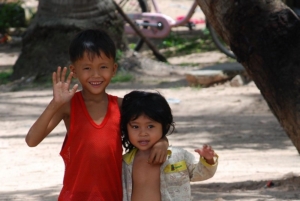The Impact of COVID-19 on Poverty in Cambodia
 Prior to the COVID-19 pandemic, Cambodia’s economy started to make an upturn due to economic growth from tourism, exports and rising wages. Poverty in Cambodia had dropped dramatically since 2009: median household income and GDP increased significantly and indicated an upward trend. However, the advent of the COVID-19 pandemic set back the economic progress that Cambodia had made over the past decade.
Prior to the COVID-19 pandemic, Cambodia’s economy started to make an upturn due to economic growth from tourism, exports and rising wages. Poverty in Cambodia had dropped dramatically since 2009: median household income and GDP increased significantly and indicated an upward trend. However, the advent of the COVID-19 pandemic set back the economic progress that Cambodia had made over the past decade.
Unemployment in Cambodia
A substantial rise in unemployment, particularly in the nation’s informal sector, took place as a result of the pandemic. The informal sector of a nation’s economy is traditionally defined as an economic sector that is neither taxed nor monitored by the government. Within Cambodia, this takes the form of service work, as well as labor in agriculture and construction. Presently available data places Cambodia’s workforce employed in the nation’s informal sector at anywhere from 80% to 93%. Around one in five workers in Cambodia’s informal sector lost their jobs due to closings, layoffs and decreased demand. Unemployment levels in the informal sector continue to remain higher than they were pre-pandemic. The rise in unemployment in turn resulted in a rise in poverty in Cambodia.
Furthermore, tourism also fell, causing significant economic losses. International visitors dropped by about 80% in 2020, causing many businesses to cease operations, lose significant revenue and business and lay off workers. This impacted businesses, from travel agencies to street food vendors. While the Cambodian government is working to offset these economic losses and independent agencies have put together recovery plans, recovery has been slow for many within the tourism industry. Many are struggling to reassert their footing in an economy that has changed so fundamentally within the past three years.
Recovery Initiatives in Cambodia
Even with the substantial negative effects that the COVID-19 virus had on the economy in Cambodia, government initiatives have worked to mitigate some of the impacts of the pandemic. One of the most notable is the country’s new cash transfer program. Implemented in June 2020, the program’s benefits have been incredibly significant. The Cash Transfer Program acted as a safety net for those classified as poor under the country’s IDPoor system, as well as for children (5 years old and younger), the elderly and the disabled. An analysis performed by the United Nations Development Program found that the cash transfer program resulted in economic growth. Poverty in Cambodia was also reduced and metrics for food security, economic productivity and health and wellness improved. The program reached over 600,000 households and over 2.7 million people across the country.
In addition, there are non-profits and NGOs working to mitigate the worst effects of poverty in Cambodia. For example, the organization M’Lop Tapang provides education, meals, community support and medical care to impoverished families and at-risk youth within Cambodia. It partners with the Cambodian government as well as several NGOs to help those most in need. Before the COVID-19 pandemic, the poverty rate in Cambodia was 17.8%. Poverty in Cambodia has increased to include approximately 460,000 more people classified as poor. M’Lop Tapang helped during the worst of the COVID-19 pandemic, delivering food to hundreds of needy families.
Looking Ahead
There is no doubt that the impact of the COVID-19 pandemic was economically disastrous for the people of Cambodia. However, Cambodia continues to improve economically one day at a time, and a return to exceptional growth for the people and economy of Cambodia looks to be a matter of ‘when’ and not ‘if.’
– Alexander Pommells
Photo: Flickr
